137 Search Results for teaching tips
October 28, 2015
by Carole Zangari -
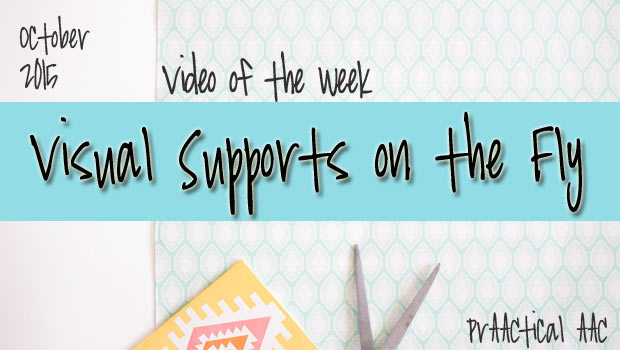
For several years, we’ve written many posts on the use of visual supports with AAC learners. One thing we haven’t talked about, though, is what to do when you’re in the midst of therapy or a lesson, and the need for an additional visual support arises. In this week’s featured video, SLP Shannon Hennig does an amazing job of explaining how she improvises to make visual supports on the fly. Like you, I appreciate the plethora of visual supports that have been appearing on Teachers Pay Teachers, SLP blogs, materials exchange sites, and Pinterest. Most of them are just adorable, some of them are well-designed, and all of them make using visual supports more convenient for busy professionals and families. In the end, though, the best visual supports are the ones that meet the needs of the situations. And, while we do our best to predict what will be needed... [Read More...]
July 14, 2015
by Carole Zangari -
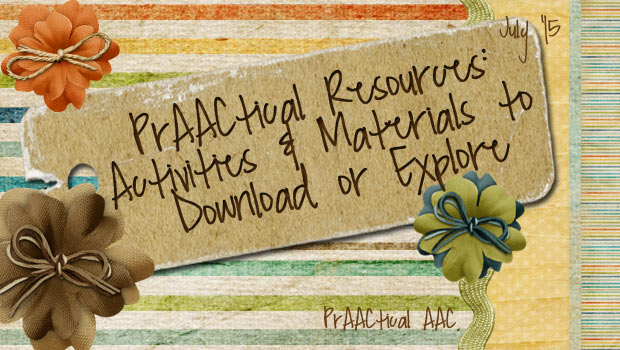
The great thing about getting stuck at an airport these days is that almost all of them have free internet connections. Some people surf the web for celebrity news, fashion tips, or recipes. AAC people, on the other hand, never miss an opportunity to search out interesting tools and resources. Here are a few from my latest airport adventure. Communication Games and Activities from AAC Scotland: Lots of fun and prAACtical ideas, like the Roving Reporter activity. Graphic Organizers with Teaching Notes: Graphic organizers are some of my favorite tools, but it takes time to convert the paper-based ones to interactive PDFs that our AAC learners can use. When I found this site from Holt McDougal (part of Houghton Mifflin), I squealed with joy. It’s a real time-saver! Story Visualizer: This website from the Education Team at Lego is a great way to motivate kids to communicate and build narratives.... [Read More...]
June 15, 2015
by Carole Zangari -

Although summer is just beginning, many SLPs in our region are already thinking about the next school year. If you are trying to increase classroom use of AAC, you will want to check out the core vocabulary resources developed by Tabi Jones-Wohleber. Tabi is a Maryland-based SLP who works on the Frederick County Public Schools AT Team. You can view her earlier post (and accompanying downloads) here. In this post, Tabi shares her wonderful Communication Opportunities Ready to Engineer (CORE) book and explains how she uses these materials. ::::::::::::::::::::::::::::::::::::::::::::::::::::::::::::::::::::::::::::::::: Classroom CORE (Communication Opportunities Ready to Engineer) Book: When posed with the question “How can I use core more?” by a group of teachers inspired to make communication a priority, I was thrilled to be part of a team motivated to investigate this exciting question. These talented Rock Creek School educators teach a diverse population of students with all manner of physical,... [Read More...]
October 30, 2014
by Carole Zangari -
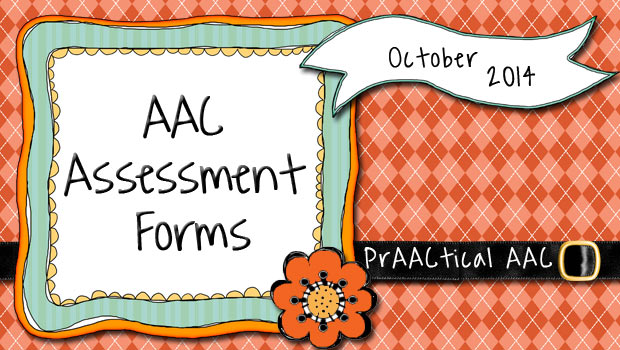
One of the challenging things about teaching graduate student SLPs to do AAC assessments is that there is no single, comprehensive protocol to cover the needs of all types of clients. We’ve started a collection of forms and thought some of you might find them helpful. If you know of others, please get in touch so we can add to the list. That way we’ll have them all in one place. Intake and General AAC Assessment AAC Assessment Protocol: Gail Van Tatenhove AAC Checklist and Rubric: Tufte AAC Intervention Rubric: Angela Standridge, Texas Region 4 Education Service Center Adult Pre-Assessment (Acquired Disabilities): Gail Van Tatenhove Adult Pre-Assessment (Congenital Disabilities): Gail Van Tatenhove Bloom and Lahey-Early Communicative Forms and Functions: Exceptional Children Division, NC Department of Public Instruction Dynamic Assistive Technology Evaluation (DATE) Collaborative Worksheet: Texas AT Network Needs Assessment: Gail Van Tatenhove Pediatric Pre-Assessment: Gail Van Tatenhove Picture Assessment: Gail... [Read More...]
July 10, 2014
by Carole Zangari -
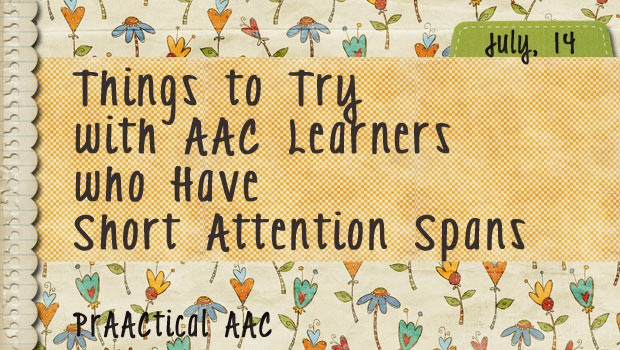
We love talking to AAC practitioners, hearing their stories, and picking up some tips along the way. Some conversations we love for the creative ideas or underlying passion. Others are memorable for less positive reasons. But still, they give us pause and challenge us to be better problem-solvers. “I love those ideas, but they won’t work with MY client: He doesn’t pay attention. He’s just not ready for all this. How do you expect me to teach someone with such a short attention span?” Glad you asked! First, don’t blame the learner. Like having short legs or frizzy hair, attention span is something over which some learners have little or no control. Their physiology is their physiology and they may not like it any more than we do. Use high-interest components in your therapy. The goals are the goals, but we can use things the client likes to make working on... [Read More...]
June 24, 2014
by Carole Zangari -
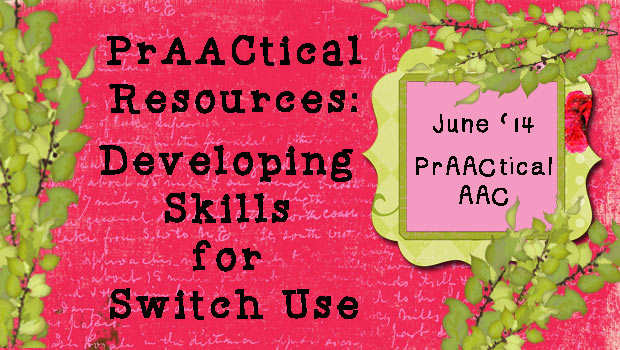
If you’re like most SLPs, you didn’t learn a lot about teaching clients to use alternative access in your graduate program. This resource document from the ACE Centre North provides a great overview of switch skills and includes a number of prAACtical intervention tips. Take a look! Direct link to handout: http://acecentre.org.uk/Websites/aceoldham/images/InfoSheets/DevelopingSwitchingSkills.pdf
January 10, 2014
by Robin Parker -

STRATEGY OF THE MONTH Supporting Pre-Intentional Communicators Breaking Through with Pre-Intentional & Beginning Communicators of ALL Ages Helping Pre-Intentional Communicators to Cross the Intentionality Bridge More Ideas for Supporting Pre-Intentional Communicators PRAACTICAL THINKING PrAActical Nominations: The 2013 Edublog Awards I was Thinking About Buying an AAC App- Now What? 5 Ways to Encourage AAC Learners 30 P0sts You May Have Missed in November How Much Time Do SLP’s In Healthcare Settings Spend on AAC Services to Children AAC Goes to the Eddies Does AAC Benefit Children with Profound and Multiple Disabilities Throwback Thursday: Talk About Me 2 3 Responses to Programs that Make Kids ‘Prove Worthiness’ Prior ro Providing Access to AAC AAC Vocabulary Lists Throwback Thursday- Past Posts About Pre-Intentional and Beginning Communicators Power Words from PrAACtical Friends A PrAACtical Christmas Carol 8 Ways to Have an AAC Holiday Season A PrAACtical Christmas AACtual Therapy with Shareka Bentham- Started from... [Read More...]
December 5, 2013
by Robin Parker -
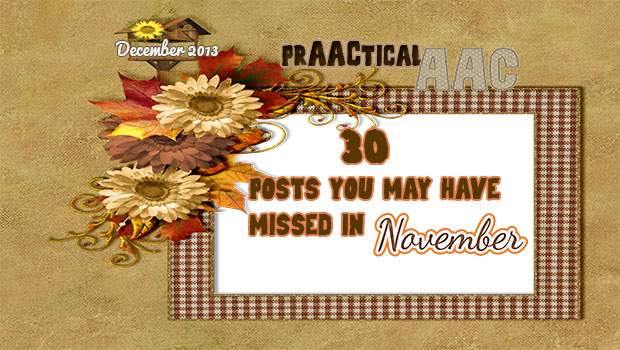
Strategy of the Month Thoughts on Teaching Core Vocabulary Teaching Core Vocabulary with Direct Instruction Strategies New Word Teaching: A Look Inside Some PrAACtical Therapy Sessions Core Words, Direct Vocabulary Instruction, & the Beginning Communicator PrAActical Thinking Fun Friday- 5 Tips for Talking About Halloween After it is Over 31 Posts You May Have Missed in October A PrAACtical Literacy Activity for Beginning Communicators Writing Goals for AAC Learners Fun Friday: Holiday Shopping with a Purpose 10 Apps to Gift to An SLP Hockey Lessons Watch it Wednesday: Using Routines to Promote Interactions by the Watson Institute Throwback Thursday: Say This, Not That to Reinforce Vocabulary Learning Fast FAACt Friday: AAC’s 1st Appearance in the Professional Literature How Do You Teach Others to Implement AAC Facilitation Skills? Watch it Wednesday: Time Timers At the Very Beginning: Working with Pre-Intentional Communicators Display Stand for Visual Supports or Books PrAACtical Thoughts on... [Read More...]
October 7, 2013
by Robin Parker -

Strategy of the Month Infusing Literacy Learning Opportunities into AAC Therapies AAC & Literacy: Setting the Stage Literacy Lessons for Beginning AAC Learners Literacy for Everyone with Adapted Books PrAACtical Thinking PrAACtical Resources: A Look at the NJC The PrAACtical Power of Contrast 31 Posts You May Have Missed in August Literacy: Cookies & Core 5 Things to Love About the SETT Framework 10 Tips to Encourage Love of Literacy 5 Easy Ways to Add Authentic Writing Experiences to Your AAC Therapy AAC & Dinosaur Apps for Literacy & Language 5 AAC Strategies and the Use It of Loose It Philosophy 10 AAC Intervention Apps We Can’t Live Without 5 Things to Consider About Prompts in Teaching AAC Loving Literacy in AAC Keep Calm & Write ON.. fro All Writers Thoughts on Involving Our Clients in AAC Vocabulary Selection Presuming Competence & Teaching AAC 5 reasons We Don’t (Typically) Use... [Read More...]
August 10, 2013
by Robin Parker -
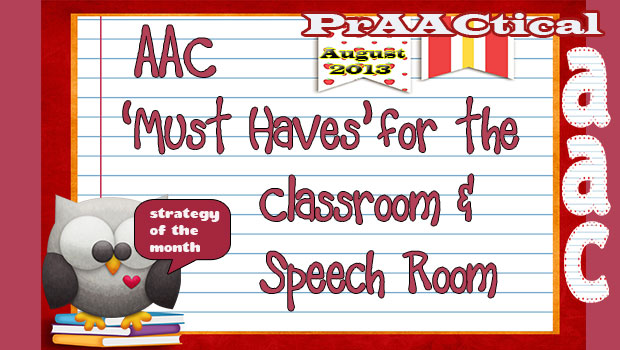
As we were getting ready for back to school and thinking about ‘must haves’, it quickly became apparent that it is not so easy to narrow it down. And the ‘must haves’ would definitely vary depending upon type of class, students, and even school. Based on a wide variety of differences, we organized a wide variety of choices to explore (we apologize in advance if we got carried away but…). Choose what you need, bookmark what you may need later and let us know your ‘must haves’ for a classroom and speech room AAC collaborative approach. We will create an ongoing list. Get Started Before School Starts Do these 10 Things to Get Started with AAC if you are new to an AAC student or classroom Provide AAC Support in the Classroom. Support teachers and educators with tips from Jane Farrall, & learn about AAC in the Classroom by Joan... [Read More...]









